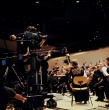Deutsches Symphonie Orchester
The Deutsches Symphonie-Orchester Berlin and the Media
During the almost 60 years that the Deutsches Symphonie-Orchester Berlin has existed, the media world has been revolutionised, and with it the presentation and dissemination of music. At the time the orchestra started work in November 1946 as the RIAS-Symphonie-Orchester, having been founded by the radio station "Rundfunk im amerikanischen Sektor" (Radio in the American Sector) in Berlin, radio was in the process of becoming the most important mass medium. There were no television programmes, and recordings, particularly LPs, were exorbitantly priced luxury articles.
Ferenc Fricsay, appointed in 1948 as the first chief conductor of the orchestra, saw the chances and the future that media offered. Together with RIAS, he decided to exploit the new developments to bring music to a wider audience. Under his leadership, regular studio and record productions became an integral part of the orchestra's work. His recordings of the works of Bartók are still considered a touchstone of musical and technical quality. When television arrived on the scene, he began with TV productions of classical music. The television film with Smetana's "Moldau" became legendary.
Lorin Maazel was able to build on these foundations. He used the areas of activity prepared by Fricsay to develop new emphases in the orchestra's repertoire. The close ties between the orchestra and the radio station, in addition to the regular public concerts, ensured that there was a constant balance between the media aesthetic and the live aesthetic. As of 1956, the radio station Freies Berlin (now merged into Radio Berlin Brandenburg, rbb) joined RIAS Berlin (merged into Deutschlandradio in 1994) in supporting the orchestra. In other words, from the very start, the combination of live performances at home, worldwide tours, working for radio and television and cooperation with the music market has been a matter of course for what is today the Deutsches Symphonie-Orchester. This network has also made it possible to bring music that has been suppressed and rarely played works to public awareness. This focus of the orchestra's work began in the eighties in the era of Riccardo Chailly (principal conductor) and Peter Ruzicka (orchestra manager), and was given a new slant in the nineties under Vladimir Ashkenazy (principal conductor and artistic director) and Elmar Weingarten (orchestra manager).
The cooperation with Deutsche Welle now gives the Deutsches Symphonie-Orchester Berlin new opportunities to work with networked media. One highlight is the production of the series "Kent Nagano Conducts Classical Masterpieces". It tries out new methods of combining live recordings, film and animation. The results will be shown all over the world in versions of various lengths, and will also be available on DVD.
The DSO also collaborates with Deutsche Welle for numerous performances abroad and concerts in the embassies in Berlin. The existing support of the orchestra by broadcasting networks in Germany - at 40 percent, DeutschlandRadio is the biggest shareholder in roc berlin, to which the Deutsches Symphonie-Orchester Berlin belongs - is thus supplemented by Germany's international broadcaster. For the DSO, this is an important step both with regard to its musical work and its image in the era of globalisation.
May 2006
Source: Deutsche Welle


